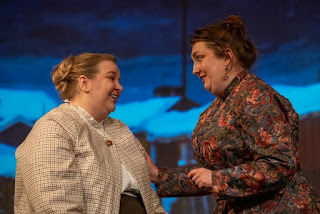"A Doll's House" by Henrik Ibsen adapted by Samuel Adamson.
Nottingham Lace Market Theatre.As far as I can remember, this is the first time that I have seen Ibsen's "A Doll's House".
The play centres on an ordinary family; Torvald Helmer, a bank lawyer, and his wife, Nora, and their children. Torvald thinks of himself as the ethical member of the family, while his wife assumes the role of the pretty and irresponsible little woman in order to flatter him.
Into this arrangement comes several outsiders, one of whom threatens to expose a fraud that Nora had once committed, without her husband’s knowledge. When Nora’s act is revealed, Torvald reacts with outrage and refuses to accept the act, out of concern for his own social standing. Nora is completely disillusioned about her husband, and declares her independence of him and their children and leaves them, slamming the door of the house behind her, to look for her own identity.
First performed in 1879, the play delves into the roles of the man and the woman, and what is expected from both genders in society. It's these expectations that cause the cracks to show in the Helmer's relationship. Nora realises that she has been nothing but a "doll" to both her father and her husband Torvald, and has been deprived of being her own person.
Women in Norway had far fewer rights in the 19th century, and it's these restrictions that bring about Nora's actions to do what she thought was right to be a responsible wife and mother.
Charlotte Thomas plays Nora Helmer. Nora plays the role of the obedient wife and caring mother who has no real struggles or responsibilities beyond this role. She has been successful, until now, about hiding her secret, and wants her husband to be happy, which is also why she is living the lie to keep up her pretence. By pretending that she's only a wife and mother, Nora realises that she deceived herself most of all. Charlotte delivers an incredibly passionate and powerful performance, culminating in an impassioned exit through the auditorium main doors.
Paul Spruce plays Torvald Helmer. His position of power at the bank transcends to the home where he thinks that he is in charge of the house and all who live within. He cares what other people think of him in the community, maybe too much, but realises too late that he is fighting a losing battle with his empowered wife. Another passionate performer, who I last saw in “A Streetcar Named Desire”, five years ago at the Lace Market.
Donna Scheffki is Kristine Linde, Nora's old school friend, who Nora has not seen for years. Mrs Linde has become a widow. She didn't love her husband but only married him so that she could support her family, as we discover from the pair's catch up speech. Mrs Linde is also a bit of a dark horse with regards to her past relationships, but can she help paper over the cracks?
Jonathan Cleaver is Nils Krogstad, an employee at the bank where Torvald is the bank manager. Krogstad is sacked and the main reason why Torvald won't re-instate Krogstad after he has fired him is because Torvald is afraid of what his other employees might say and that they might think that Torvald is weak. Jonathan shows, not only the scheming side of the bank employee, but also a softer side later on in the play, but boy can Jonathan play scheming characters well!
Jack Leo plays Dr Rank, a friend of the Helmers. Rank doesn't like Krogstad, and makes his opinions known to Nora and Torvald. The good Doctor is also not in the best of health and reveals to Nora just how ill he is.
Janice White plays Anne-Marie, the Helmer's maid, who spends most of her time looking after the Helmer's two children, which are heard but never seen.
Directed by Cynthia Marsh, all of the tension that I had hoped for was there, including a few moments that quite shocked me. The controversy that Ibsen had included all of those years ago remained for me, especially with the way that Torvald treated his spouse.
Set Design is by David Babington, and while the set is sparse, the visual backdrop provides all we need. While I love a busy vintage set, this design shows that with just a few items; wooden chairs, hat stands, an electric fire, portraits etc provides a certain physical choreography for the actors, giving all your attention on the words of the script and the delivery from the actors.
The paintings, that depict the views from the Helmer's windows reference the artistic talents of Norwegian artists.
Lighting Design is by Hugh Philip, again with many Lace Market theatre lighting designs, simplicity is the most effective method, and that is the case here.
Sound Design is by Matthew Allcock, and we also get a taste of Norway from the music of Grieg, including one of my favourite pieces, "Morning" from "The Peer Gynt Suite".
The costumes, especially that of Helmer, are incredibly stylish, including a proper bow tie to go with the classic black and white dinner suit. The outfit that Nora wears to perform the Tarantella - an Italian dance normally performed at a wedding, and occasionally still is performed for occasions of importance - is rich and colourful.
Responsible for this area of the play is Doreen Sheard, Max Bromley and the rest of the Wardrobe crew.
If you want to see a play that really does deserve the label "classic", which still can shock an audience, performed with power and passion, then this is the one to head to this week.
"A Doll's House" is at the Nottingham Lace Market theatre until Saturday 20 April.







No comments:
Post a Comment